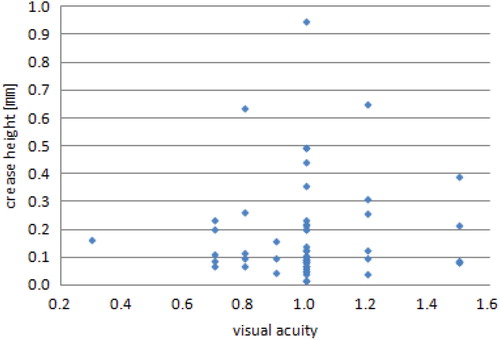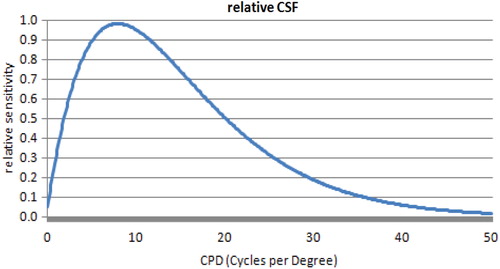Abstract
There is a growing possibility applied to the foldable display for mobile devices because consumers want to see the big screen and they prefer mobile devices easy to carry around. However, a foldable display has crease because it generally uses laminated films or plastic substrates. In this study, we conducted the experiments in which people perceive crease on the flexible display for the various display viewing environments. The result shows that subjects most easily perceived crease in a bright room and panel off-state when the folding radius is 5 mm (5R). They perceived crease at an average height of 143 µm in that condition. The subjects perceived crease at an average height of 185.5 µm in the outdoor with display off condition. Also we analyzed that the subjects perceived the crease better when the folding radius of the flexible display was smaller than 5R. We expect that this study will contribute to the standardization of the new assessment method and to setting perception standards for the flexible display.
1. Introduction
Galaxy Round was released in October 2013, G-flex was released in November 2013, and Galaxy Note Edge was released in September 2014. Galaxy S6 Edge was introduced at the Mobile World Congress in March 2015. The display products made of plastic substrate have been coming out in the market. Display products that can be bent are expected to be available in more and more evolved form. It seems that foldable displays have been applied to mobile devices because customers want to watch a large display and carry it around easily.
Foldable displays generally use not glass but plastic window which has good tensile capacity and flexibility. A plastic window has the advantage of bending but it takes time to restore to its original state. Because of that reason, there remains a line shape mark at the folding part of the display after unfolding it. A crease is defined as a line or mark made by folding or doubling any pliable substance [1]. Pathways used this term as wrinkles having wavy-like shape [2]. So we defined the mark on a flexible display by folding as a crease.
In this study, we conducted an experiment on how crease is cognized in a dark room environment and in a bright room environment by turning on and off a display. We conducted an additional experiment by turning off the display in the dark room condition which was the most well-recognized condition.
2. Experiment
In the first experiment, the device of Figure was made in order to determine the minimum recognized creasing height. By attaching a display panel to the plates of the device, the height of crease increases or decreases by controlling the dial gauge. The length of the unattached part of a display panel to plates of a device is 15.7 mm. It is a length corresponding to a radius of 5 mm when folded.
Subjects were instructed to turn the dial gauge until they felt any change in the height of the display panel in different illumination environments and in different viewing degrees. In addition, they were instructed to respond as to whether any change is felt (Figure ).
Figure 1. The crease-producing device. It is possible to adjust the crease height by controlling a dial gauge on the right side of the device.
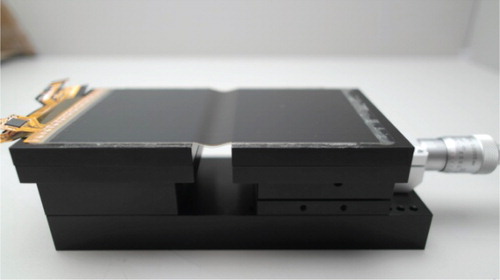
Figure 2. A subject adjusts the dial gauge to watch the display panel to the normal direction and the oblique direction.
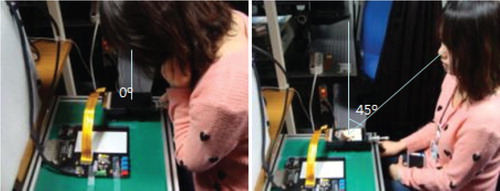
Figure 3. The patterns used in the experiment. Full white (first from left), a web-captured screen (second from left), a person's face (third from left), and full black (right).

The total number of participants was 17; 11 male and 6 female. There were 4 participants in their twenties and 13 in their thirties. The average of corrected visual acuity was 1.0±0.1. There was no case of color blindness or color weakness.
The surface illumination of the display panel in the bright room environment was about 300 lx. The observation distance was 25–80 cm with non-strict constraints for the observers to select their most visible distance.
Viewing direction was the normal direction and the oblique direction of the display panel.
In order to confirm the effects of the kinds of patterns, we used a full white pattern, a web-captured screen pattern, a person's face pattern, and a full black pattern (Figure ).
In the second experiment, we instructed the subjects to turn the dial gauge until they felt flexion of the display panel in outdoor environment to ensure that the minimum perception height of a person. The panel was off state (Figure ).
Figure 4. The crease experiment was performed outdoors. Subjects were instructed to turn the dial gauge until they felt the bending of the display panel in sunlight environment.
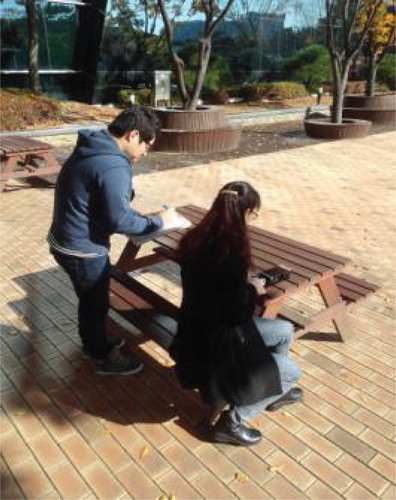
In this experiment, the total number of participants was 54; 37 male and 17 female. The average of corrected visual acuity was 1.0±0.03. There was no case of color blindness and one of color weakness. The number of participants in their twenties was 21, thirties was 26, forties was 6, and fifty was 1.
3. Result and discussion
3.1. The first experimental result
In the first experiment, we have analyzed the effect of the illumination, viewing direction, and pattern.
As shown in Table , the subjects started to recognize the crease at an average height 437 µm in the dar kroom and recognized the crease at an average height 367 µm in the bright room. We can see that the crease is more easily recognized in the bright condition compared to the dark condition from this result.
Table 1. The average height at which subjects start to perceive crease.
Looking at the influence of the viewing direction, subjects recognized the crease well when watching a display from the oblique direction than from the normal direction. The average height at which subjects recognized the crease was 464.5 µm in the normal direction and 339.5 µm in the oblique direction.
Subjects did not answer consistently for pattern change unlike viewing direction. When watched in the normal direction, subjects easily perceived the crease because they could see the curved line or crooked letters. On the other hand, when watched in the oblique direction, subjects responded that the white pattern was easily perceived because they could see the change of luminance as shown in Figure .
Figure 5. The luminance change caused by crease in the oblique direction in the dark room condition. No crease (left) and 100 µm crease (right).
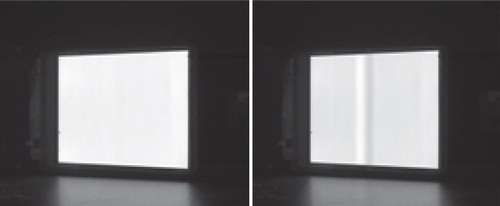
The perceived crease height was very different between the normal direction and oblique direction for the white pattern. The crease perceived height in the dark room condition was 570 µm in the normal direction, while it was 244 µm in the oblique direction. So the difference of height in the viewing direction was 226 µm. The crease perceived height in the bright room condition was 525 µm in the normal direction, while it was 179 µm in the oblique direction. So the difference in the viewing direction was more than double.
The recognition of human face is so important that there is a specialized face processing area in the brain which is called the fusiform face area [Citation3]. Because of this reason, we expected that subjects would easily recognize the change of face by crease, but they did not recognize it easily even when the crease height was large. We expect that it would be more difficult to recognize the difference in general images because there are more degrees of freedom than face images.
The crease was most easily observed when they observed the full black pattern from the oblique direction in a bright room. They recognized crease height change of average 143 µm. Subjects responded that reflection was the main factor for a perceived change in the display panel. The reflection light was observed well when the display panel was off in the bright room. In this condition, the most sensitive participants were aware of the height change at only 37 µm.
To sum up, the observers recognized the crease by the changes of the screen image itself in the dark environment. The web pattern was recognized well because straight lines in the pattern were bent. Observers also recognized the crease well for the full white image in the oblique direction because the lightness was different at the crease area. This is due to the characteristics of the panel white angular dependency (WAD). Some of the viewing angle changes from the normal direction do not significantly affect the luminance change but the change of viewing angle from the oblique direction makes a large difference to the luminance from a contiguous area. The different results can occur from this experimental result if the luminance of a panel does not change depending on the viewing angle.
The reflected light affects the recognition of crease in the bright room environment. The observers were more affected by reflected light when the image was dark and simple than bright and complex. Because of this reason, observers recognized crease well when they used a black pattern in both the normal direction and oblique direction. However, there was no big difference in the recognition of crease by viewing angle in the case of using bright image because specular light did not enter the eyes.
3.2. The second experimental result
The first experimental result showed that subjects perceived the crease height most easily when they viewed the display panel in the off condition in the bright room. We conducted further experiments to observe the off-state panel outdoors to determine a more precise reference.
Figure is a distribution graph with a bin size of 5 µm. The minimum height measured in the experiment was 14.7 µm, the average height was 185.5 µm, the standard deviation was 181.3 µm, and the standard error was 24.7 µm.
Figure 6. The frequency distribution graph (blue bar) and the cumulative distribution graph (red line) of crease height at which subjects recognized the change in the display panel.
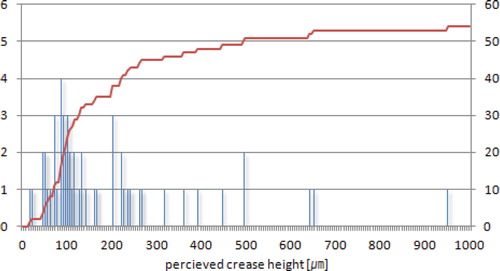
The percentile calculation results of the perceived crease height of the panel based on the measured data are as shown in Table .
Table 2. The perceived crease height percentile.
There was little correlation between visual acuity and crease height sensitivity as shown in Figure . The correlation coefficient was 0.046.
The average height of the crease which women perceived was 151.1 µm and the standard deviation was 97.4 µm. The average height of the crease which men perceived was 201.3 µm and the standard deviation was 208.2 µm.
The perceived crease height was 160.6±25.1 µm in 20s, 230.6±45.3 µm in 30s, and 92.8±21.3 µm in over 40s. Age was less related to the sensitivity in perceiving crease.
Human's contrast sensitivity varies according to spatial frequency. We can represent this using contrast sensitivity function (CSF) [4].
Figure shows that human visual contrast sensitivity is most increased around 8 cycle per degree (CPD) and the sensitivity is decreased at higher or lower spatial frequency.
At a distance of 25cm, generally known as the viewing distance of a mobile phone, the spatial frequency of crease is 0.28, 0.35, 0.46, 0.69, and 1.39 CPD and the relative contrast sensitivity is 0.13, 0.15, 0.18, 0.24, and 0.40 when the folding radius is 5, 4, 3, 2, and 1 mm, respectively. We can learn from this that humans become more sensitive to the display contrast when the folding radius is smaller. There is luminance difference in the crease area which is originated by the panel WAD or reflective light. In view of these facts, people notice a crease more easily when the folding radius is smaller than 5 mm.
4. Summary
In this study, we were aware that the environmental factor that had the greatest impact on the crease perception was reflected light. The minimum perceived crease height was 14.7 µm when the panel was off and in the outdoor condition in which one can easily observe light reflection.
The display user recognizes the crease easier in the oblique direction than in the normal direction. When a user watches a display held in the hands, the angle between eye and display surface is almost 90°. However, the user sometimes watches a display on a table. In this case, the viewing direction is not normal; so the user more easily perceives a crease.
The subjects recognized crease well with the web page pattern in the normal direction because they observed a curved line in the pattern. The subjects perceived crease well with the full white pattern in the oblique direction because they observed luminance change by WAD.
Visual acuity and age had low relative correlation with crease perceiving sensitivity but women were more sensitive than men.
People can more easily perceive crease when the folding radius of the display is smaller because human contrast sensitivity varies according to spatial frequency of objects. More study of the structure or material that can minimize the occurrence of a crease is required for flexible display because curving of image or changing of luminance is a factor that ultimately has an effect on the image quality. Also we think that standardization of the method for the quantitative evaluation of the crease is needed.
Additional information
Ja Eun Lee received her B.S. in computer engineering from Kyungpook National University in 2001. She worked for SDS in system security for three years. She received her B.S. in physics from Kyungpook National University in 2006. She obtained her M.S. (2008) and Ph.D. (2011) in physics from KAIST. After graduation, she joined Samsung Display Co., Ltd. in 2011 where she worked on the display evaluation and visual fatigue research and standardization.
Seungbae Lee is a master engineer in Samsung Display Co., Ltd. He received his B.S. in chemistry and his M.S. in material engineering from Korea University. He received his Ph.D. in image science from Chiba University in Japan. He has researched on metrology standardization of display image quality. His main interests are color science and vision science in display characteristics.
Jaewoo Bae is a principal engineer in Samsung Display Co., Ltd. He has researched on optics and evaluation of display image quality.
Minjeung Lee received her B.S. in informational engineering from Hansung University in 2001 and M.S. in electronic engineering from Yonsei University in 2003. After graduation, she has researched on display evaluation in Samsung Display Co., Ltd since 2003.
Chulgyu Lim received his B.S. in electronic engineering from Dankook University in 2000. He worked for Bellwave Co., Ltd. as mobile phone hardware development engineer until 2006. After he joined Samsung Display, he has been working on the display development and evaluation of displays.
Youngsang Ha received his B.S. in electronic engineering from Kyung Hee University in 2011. After graduation, he joined the Samsung Display in 2011 where he worked on display evaluation and color research.
Eunjung Lee received her B.S. in electric engineering from Ewha Womans University, Seoul, Korea. She received M.S. degree in information and in communication engineering from Sungkyunkwan University, Suwon, Korea. She is in Samsung Display as an engineer for the image quality assessment of displays. Her research interests include the organic light emitting diode (OLED) display technology, flexible display technology, and the image quality assessment.
Byeonghwa Choi received his B.S. electronic materials engineering from Kwangwoon University in 1997. He has been working on display image quality assessment after join Samsung Display Co., Ltd. Also, he is interested in flexible display ergonomics.
Sungsu Hong received his B.S. in machine design from Hongik University in 1993. He received his M.S. in precision mechanical engineering from Hongik University in 1995. He joined Samsung Electronics (LCD) and Samsung Display in 1998 and 2009. Since 2010, he has been working on evaluation and research for flexible display in Samsung Display.
Jangdoo Lee is vice president in the Display Research Center at Samsung Display Co., Ltd. He obtained his B.S. degree in physics education from Seoul National University in 1988. He obtained his M.S. degree and Ph.D. degree in physics from KAIST in 1990 and 1993, respectively. Since joining the Samsung Display Co., Ltd., he has been working on the development of flexible display, transparent display, and high-resolution OLED display.
Sungchul Kim is executive vice president in Samsung Display Co., Ltd. He obtained his B.S. degree (1985), M.S. degree (1987), and Ph.D. degree (1992) in physics from Kyung Hee University. He had worked in LG electronics for 10 years. After that, he joined SDI as vice president. He has been working on the development of flexible display, transparent display, and high-resolution OLED display.
References
- Webster's Revised Unabridged Dictionary, edited by Noah Porter (G & C. Merriam Co., 1913).
- X. Chen and H.-H. Dai, Soft Condens. Matter (2014) [arXiv:1410.8227].
- K. Grill-Spector, N. Knouf, and N. Kanwisher, Nat. Neurosci. 7, 555 (2004). doi: 10.1038/nn1224
- Contrast Sensitivity Function (1997). <http://www.cg.tuwien.ac.at/research/theses/matkovic/node20.html>.

